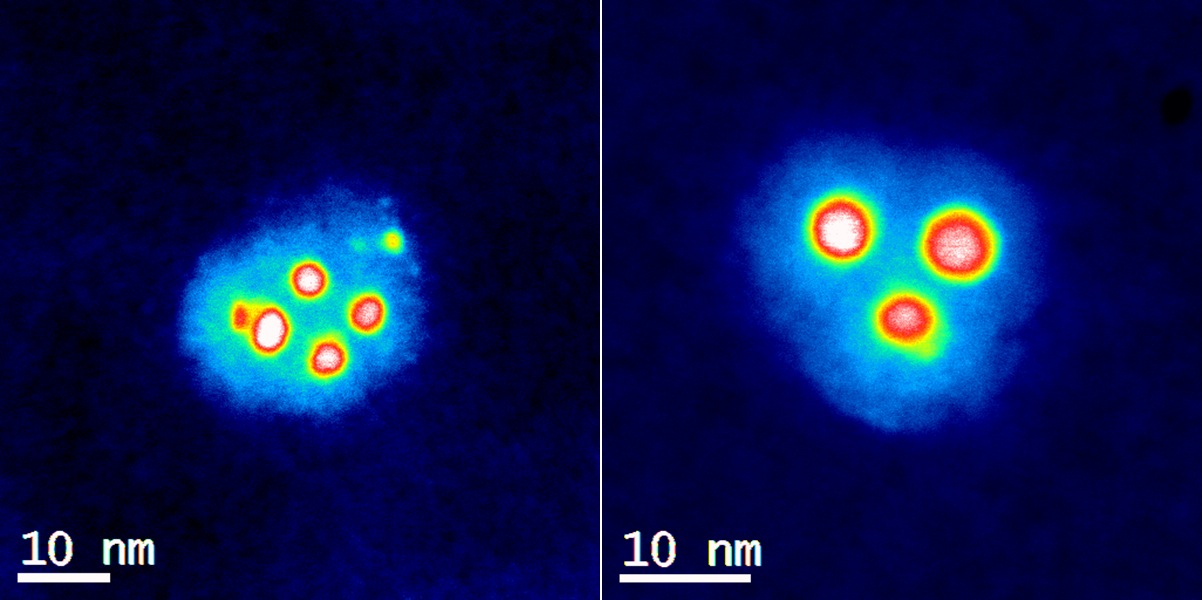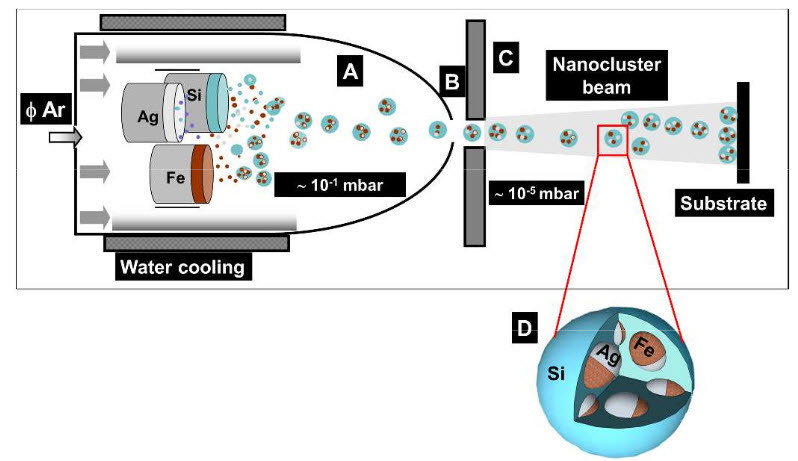Three-part nanoparticles for biomedicine eliminate biocompatibilty, storage problems
March 10, 2014

Hybrid nanoparticles with four and three multicomponent cores (iron-silver) embedded in a biocompatible shell (silicon) (credit: OIST)
Researchers in the Okinawa Institute of Science and Technology (OIST) Nanoparticles by Design Unit have created nanoparticles for biomedicine that address current problems with biomedically relevant nanoparticles, such as:
- Nanoparticles are primarily made using chemicals, which may be harmful to the patient.
- The fabrication process takes several steps, the size of the particles is difficult to control, and the particles can only survive in storage for a relatively short amount of time.
They have created biocompatible ternary nanoparticles, meaning they consist of 3 parts that each exhibit a useful property, and have done it without the use of chemicals. The new method allows for easy manipulation of the size of the particles to tailor-make them for a variety of uses all in one step. The researchers have also developed a method that provides better stability for longer storage.

Single-step synthesis of ternary hybrid nanoparticles composed of multiple iron-silver (Fe-Ag) cores encapsulated by a silicon (Si) shell using a versatile co-sputter gas-condensation technique (credit: Maria Benelmekki et al./Nanoscale)
The three nanoparticles in the study are made of a core of iron (makes them magnetic, allowing researchers to move them around) and and silver, which excellent for imaging because excitation of silver creates a larger detection signal than the particle itself, meaning it can be viewed with conventional microscopy or medical imaging devices despite its tiny size.
The third part of the nanoparticles is a silicon shell, which surrounds the iron-silver core. The silicon is biocompatible (it can go into a patient without creating complications), it prevents the core from being broken down, and it can be easily manipulated for use in a variety of biomedical applications. The nanoparticles also have superparamagnetic behavior, meaning they are only magnetic when a magnetic field is applied, so their magnetic property can be induced and controlled for specific purposes.
They published their findings in the journal Nanoscale. The implications of the work are potentially vast, said lead author Maria Benelmekki. “The ternary nanoparticles can be used in different applications, such as a contrast agent in MRI, biomagnetic sensors, hyperthermia for cancer treatment, and magnetically targeted delivery and transfection.”
“Currently, the performance of these nanoparticles is being evaluated (in vitro) for cell tracking and as an MRI contrast agent,” Benelmekki told KurzweilAI. “Once the evaluation is concluded and the synthesis process is scaled up, the particles will be commercialized.”
Abstract of Nanoscale paper
We report a facile single-step synthesis of ternary hybrid nanoparticles (NPs) composed of multiple dumbbell-like Iron-Silver (FeAg) cores encapsulated by a silicon (Si) shell using a versatile co-sputter gas-condensation technique. In comparison to previously reported binary magneto-plasmonic NPs, the advantage conferred by a Si shell is to bind the multiple magneto-plasmonic (FeAg) cores together and prevent them from aggregation at the same time. Further, we demonstrate that the size of the NPs and number of cores in each NP can be modulated over a wide range by tuning the experimental parameters.